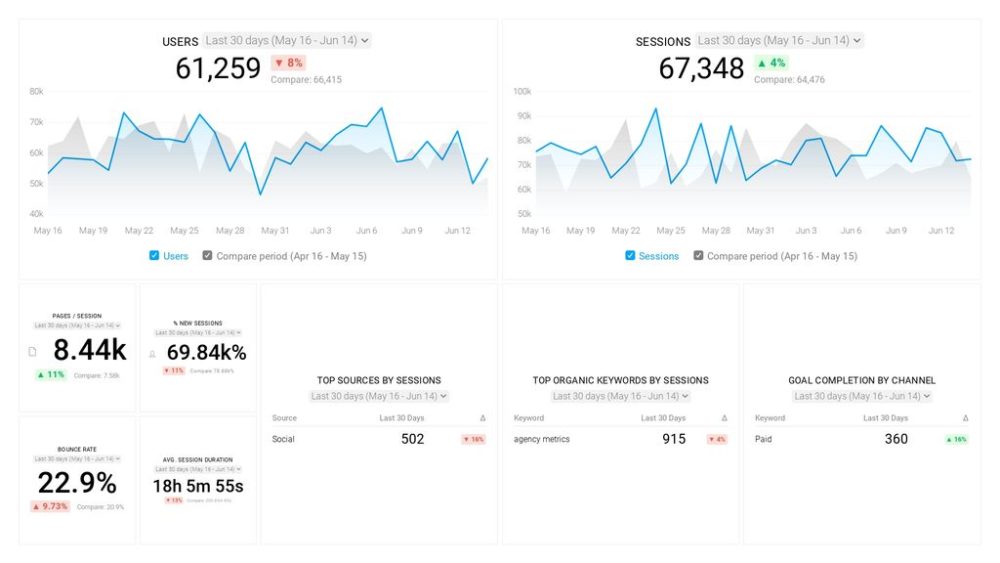Table of contents
Conversion rate optimization (CRO) is a powerful path toward growth. But it can also be an incredible waste of time if you’re not measuring the right KPIs or focused on the right things.
You might have trouble finding the “right things” to measure, when almost everything–from your onboarding process to website design–can be optimized.
How do you know which to prioritize?
We asked that question to 33 experts, who each shared their process for identifying CRO opportunities that actually impact growth.
Here’s what they said.
1. Put yourself in your customers’ shoes
When we asked for WeTeachCRO‘s best tip to identify CRO opportunities, Matt Scaysbrook’s answer was simple: “Stop thinking about “websites” and start thinking about people – websites are merely a means to interacting with people on a grand scale.”
“Who are those people you want to influence, what do they care about, what do they worry about and how can you emphasise the former and mitigate the latter?”
The Good‘s Wolfgang Warneke agrees: “Base your user personas from real people and listen. Really tune in. Get into their mindset and test toward crafting a full experience where they feel at home and belong.”
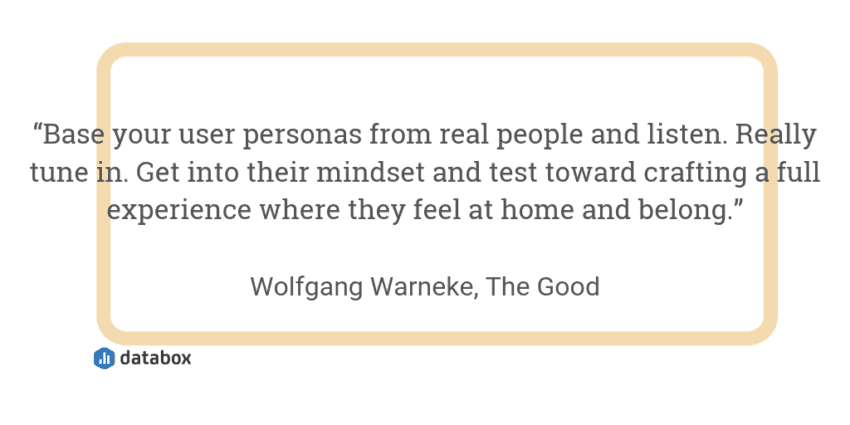
This mindset should underpin your entire CRO strategy.
2. Narrow your target audience
“One way for identifying CRO opportunities is narrowing the scope for your intended target market,” writes Lizzie Dunn of Fundera.
“Stuffing your website with content that is relevant to a large scope of users will single out no one. However, being specific and intuitive about the user journey and what you intend to offer will create an experience that users are much more likely to convert in.”
It makes sense, right? You could be driving 50,000 visitors through organic search–but if just a handful are your ideal customers, you’ll struggle to craft content that speaks to them directly.
(That could explain why the average conversion rate of an ecommerce website is just 2%.)
Dunn explains that “by narrowing your scope, you can create a strong CTA through a more intimate, personalized experience, which is where high-leverage conversions are generated.”
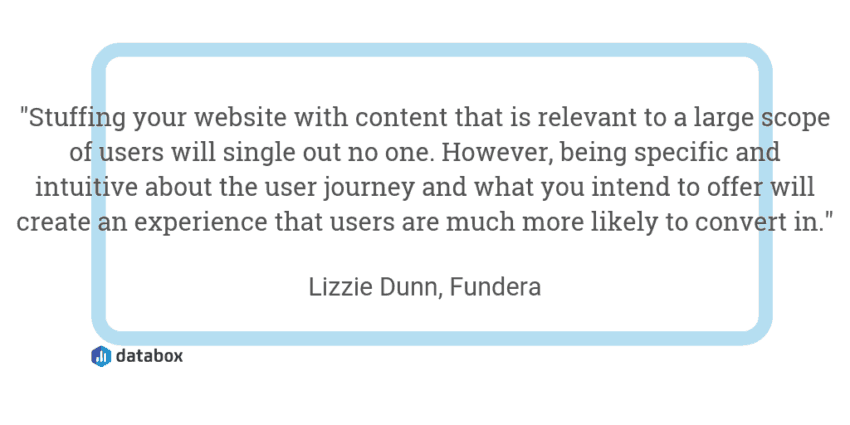
Summarizing, Alexandra Zelenko of DDI Development says: “Just in-depth understanding of your target audience, aligning your value proposition to your customer’s value perception in their language is what you should focus on to reach excellent results.”
PRO TIP: How to track these 10 popular Google Analytics 4 metrics
Sure, there are dozens (and dozens?) more Google Analytics 4 metrics you could track. But, starting with these 10 commonly tracked metrics will give you a pretty high-level view of how your marketing is working…
- Sessions: The number of sessions can tell you how many times people are returning to your website. Obviously, the higher the better.
- Sessions by organic keyword: Which organic keywords bring in the most traffic to your website? This may help you determine whether your SEO investments are paying off.
- Bounce rate: Do visitors leave shortly after landing on your website? Or do they stick around?
- Average session duration: How much time are people spending on your website? Users with a high average session duration are most likely relevant to your company.
- Goal completions: How many users responded to your call to action?
If you want to track these in Google Analytics, you might find the visualizations limiting. It’s also a bit time-consuming to combine all the metrics you need in one view.
To better understand how your website performs in terms of traffic growth and conversions, we’ve made this plug-and-play dashboard that contains all the essential metrics for understanding how successful you are at optimizing different aspects of your website.
You can easily set it up in just a few clicks – no coding required.
To set up the dashboard, follow these 3 simple steps:
Step 1: Get the template
Step 2: Connect your Google Analytics account with Databox.
Step 3: Watch your dashboard populate in seconds.
3. Start monitoring URLs with a large volume of pageviews
Remember how earlier, we mentioned that identifying CRO opportunities have a trapdoor to wasting time?
Juli Durante of SmartBug Media agrees, and thinks “you have to make sure you’re spending your time in the right place, which often means reverse-engineering which opportunities will help you reach your goals more quickly.”
Durante puts this into practice with two pages: “When conducting an analysis, we might find that they look pretty much the same: they both have a 60% bounce rate, they both have calls to action with a 3% click-through rate, they both see about 55% of visitors reaching the footer on the page.”
“You might logically conclude that you could run an optimization test on either page… but I’ve left out an important metric: the number of views each page will get in a typical month.”
Durante continues: “Page #1 gets about 500 views a month, while page #2 gets 5,000. When we talk about focusing on which page to start optimizing, I’d start with page #2. If you saw the CTA click-through rate increase by 1% on either page, you’d see 5 more CTA clicks on page #1, but 50 more CTA clicks on page #2.”
“If you were asking visitors to click through to a landing page for a demo or consultation (or another bottom-of-the-funnel opportunity), just choosing the right page at the beginning of your test could help you see many more sales-ready leads.”
*Bonus content: Watch as Durante walks us through how to leverage data to find your most promising CRO opportunities on your landing pages.
4. Optimize low-converting landing pages
“Improving the landing pages of website to increase the chance that visitors will go beyond the first page and minimize bounce rate is what I look into first,” explains Rajat Chauhan of Techtic Solutions, Inc.
That’s because Chauhan thinks “the key here is to focus and identify the lowest hanging fruit that is most likely to bring large improvement in the experience of core audiences and ultimately conversion.”
It’s true; landing pages tend to account for a huge volume of conversions. The top 25% have a conversion rate of 5.31% or higher.
Sam Underwood’s team at Futurety investigate at these pages, too–only the team at Futurety look at the conversions for each landing page by channel: “What pages tend to lead to conversions more often than others, controlling for channel and campaign?”
“When running paid campaigns, we often A/B test using the homepage vs a dedicated landing page as the destination for an ad, which can return some surprising results!” Underwood explains.
Growth Hackers‘ Jonathan Aufray also “track[s] pages that get the lowest conversion rate and we compare them to the pages with the highest conversions.”
Aufray’s team then use this data to “find what can be improved on these low-converting pages (Copy, CTA, etc.) and we run tests.”
5. Find holes in your sales funnel
It makes sense to focus on CRO opportunities that have the potential to supercharge sales, right?
That’s why ceo.digital‘s Steven Kent advises to “follow the money. By that I mean always go to the step before conversion first.”
“By improving conversions here, you’ll have the biggest opportunity to impact your bottom line, because after this step is the conversion. Whereas if you optimise further up the funnel, there’s still places where your conversion funnel can leak.”
Jennifer Lux also consults the sales funnel for CRO–only the team at LyntonWeb study “which marketing activities contribute to new customer acquisition.”
“For example, your data might suggest that your customers always request a live demo, or download a certain white paper along their path to purchase. When you know these high-value conversion points in the buyer’s journey, you can optimize the landing pages and/or forms aligned with these attribution activities.”
“These are your high-leverage or high-value CRO opportunities,” Lux summarizes.
adMixt‘s Zach Greenberger values this process more than A/B testing, which “can be time-consuming an expensive. It can be more efficient to test different strategies at the very top of your funnel, with your paid marketing.”
“It can be cost-effective to reach a wide audience and test different creative and messaging styles, across multiple audiences. When you have clear learnings, you can deploy them to your website with confidence that your target audience will respond favorably.”
Summarizing, Emily Schreiber of Thrive Internet Marketing Agency says: “Dig into the data and analytics of the sales funnel to look for gaps or drop-offs in engagement. By targeting a specific issue within your funnel, your resources will be used more effectively as you build a strategy for optimization and test different hypotheses.”
6. Scrutinize your onboarding process
Tamas Torok works with a company in the cryptocurrency agency, which helps customers learn how to trade without risking real money. Part of their software includes an “an onboarding process, helping users to learn more about the most critical parts of the app.”
However, Torok thinks “completing the onboarding is crucial because we discovered its correlation with retention. Retaining users is crucial. Every stage of the funnel and user actions are measured; every step is an opportunity to improve conversion rates. This way we know what percentage of the new users complete the onboarding process.”
Before overhauling their onboarding process, Torok’s team “had a 31% completion rate which is relatively low. So we created a chart showing all the drop-offs in every single step of the onboarding process. We identified one stage where the drop-off was the highest and focused all our efforts to improve conversion rates.”
The result? Torok says: “By focusing on the bottlenecks of our funnel, after 2-3 iterations we were able to decrease drop-off rate at the worst performing step and overall reaching a 41% completion rate.”
7. Pit yourself against competitors
Michael Alexis of Team Building Chicago thinks a “quick way to identify conversation rate optimization opportunities is to learn from your competitors.”
…After all, they might have already done the work by testing what your shared audience is responding to.
“Look at your top three competitors and see if you can identify patterns or unique characteristics on their landing pages. For example, do they all use specific phrasing? Or does the style/design of one page seem to stand out from the rest? You can then adapt these items to test on your own site.”
However, Alexis’ tip comes with a caveat: “I wouldn’t recommend copying exact phrasing, but there may be keywords or tone that you could use as well.”
8. Calculate earnings per click
David Sanchez of Mammoth Web Solutions thinks that “calculating the earnings per click is a powerful measurement of success in conversion optimization. You calculate it by multiplying the customer lifetime value times your conversion rate.”
Sanchez continues: “This formula helps you to see how much you can afford to pay per click and still profit from every conversion through that campaign.”
The approach is simple: If your earnings per click significantly outweigh your advertising CPC, it’s time to optimize.
9. …along with click ratio and conversion page assist
Digital 22‘s Thomas Knowles measures two things when identifying CRO opportunities:
- Click ratio: Also known as click-through rate; the percentage of people who click your link in comparison to those who were exposed to it.
- Conversion page assists: URLs that customers visited before they converted.
“You want to concentrate on the amount of clicks the visitor can complete on each page of your website,” Knowles explains.
“When on a Conversion Assist page or a lead generation page you want the visitor to complete the desired outcome (click the CTA, complete the form, download content), having a low click ratio on these pages excludes any distractions and points the visitor to the desired outcome.”
10. Collect data using surveys
“Imagine a scenario where a prospect browses your site for information about a product he or she is intending to buy,” writes Alexander Kesler of inSegment. “Unable to quickly locate the information, the prospect promptly exits the site. You got them to click on your site, but you couldn’t convert. What happened?”
You don’t need to be a genius to figure it out.
According to Kesler, the answer lies within asking: “Questions that prompt users to share where they may have experienced difficulties are particularly useful for helping you find what stopped them from converting on a particular page.”
“You may have missed a conversion opportunity because a prospect didn’t find what he was looking for–an easy fix you could provide when they respond to your survey. But you’ll never know what stopped them from converting unless you ask,” Kesler summarizes.
Stan Tan of Selby’s also uses this tactic, but recommends asking one simple question: “Ask your existing clients why did they choose your product or service. Use this info to improve your messaging on your website and landing page.”
11. Record on-site behavior
“Some marketers aren’t in love poring over reams of data,” explains Nextiva‘s Yaniv Masjedi. That’s why their team recommends to live record your visitors–a tactic that “works well for the non-data head, which may sound ironic, given we’re talking about CRO.”
Masjedi continues: “If you want to find CRO opportunities, watch replays of visitor activities on your website. Which buttons do they hover over, but flit away from? Where is their eyesight drawn to?”
If you fancy recording on-site behavior, you can use tools like Crazy Egg or HotJar to record the activity happening on your website.
As Dane Saville of Reunion Marketing explains, these tools give “you insights about how people are behaving on your high-intent, conversion-oriented pages, as well as seeing where people hover and spend time on your site that lack opportunities to perform a macro- or microconversion on the site.”
Saville summarizes: “Once you understand how people are behaving, you can implement best practices and data-driven strategies to satisfy user expectations that will yield better conversions.”
12. Run rounds of user testing
“One of the most valuable ways to discover the conversion killers on your site is user testing,” says Dexter Agency‘s Joris Bryon.
User testing is the process of recording the actions people take on your website. It’s similar to heatmapping–but with user testing, you’re participating in one-on-one feedback, and hearing your customers’ opinions as they flow through the process.
“Hearing them voice their opinion is the most valuable part of user testing because you can know rather than assume what they’re thinking. You’ll see how they use your site, where they get stuck, what they like and dislike, how they would like to use your site.”
However, Bryon advises against limiting user testing to live websites: “You can do it at any stage of a (re)design. If you’re making big changes to your site, then you’re probably going to do that on a staging version first. Well, it’s perfectly possible to do user testing on the staging version of your site.”
“That way you can find and fix a lot of issues before you actually go live – this can possibly save you a ton of money!” Bryon explains.
Ethan Cotton of The Good agrees: “Putting the site into the hands of someone who is unfamiliar, but fits into the profile of your audience, will unearth friction points in their experience that data analysis can’t always uncover.”
But instead of focusing solely on the things they like, Cotton advises to “make sure to ask what they DON’T like and what they would change if they could.”
Pawel Ogonowski of Growcode has a similar philosophy: “Winning in conversion rate optimization is all about two things: understanding your users’ problems and solving them.”
That’s why Ogonowski recommends asking your customers “What nearly stopped you from shopping with us?”, and using the questions below to validate your changes:
- “Can you support the suggestion with other data (e.g. from Google Analytics or other research)
- How big the impact is going to be (does the suggestion refer to a high volume webpage/template).”
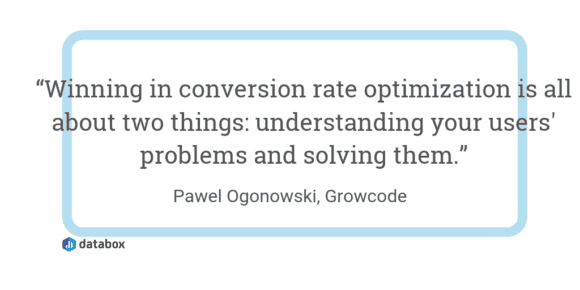
13. Create bubble charts
Do you log into your analytics dashboard and feel overwhelmed with numbers? You might benefit from bubble charts–a graph that “show conversion performance of the 10 most visited pages or posts on the website,” according to Branko Kral of B King Digital.
However, Kral notes that “the same [concept] can be applied to [other] channels.” For example: “You monitor and test whether the budget increase worked. We say yes it did if conversion rates or values didn’t drop per session, after we increased the amount of sessions for that piece or channel.”
Kral’s team put this into practice when they decided to increase their Google Ads budget:
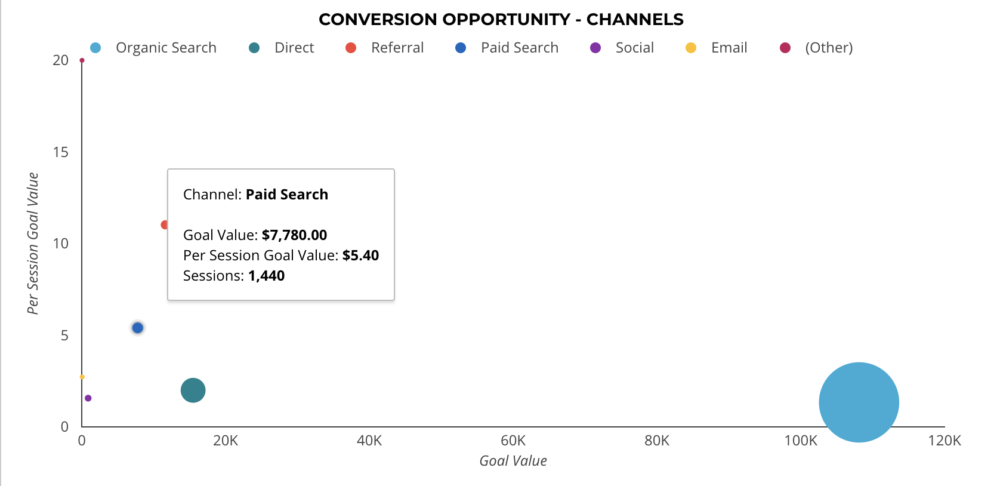
“As much as organic search generates the most value for the website by far, we’re already working hard on that. To boost another channel in the mix, referral was a consideration because it had the highest per session goal value. But we only control referrals so much. Google Ads was a clear candidate for more priority, and we did indeed keep up the per session goal value after the budget increase,” Kral explains.
When you’re using bubble charts for CRO, “goal value here is a combination of a conversion rate and the value of individual conversions.” Kral’s team “use it because there are big differences between respective values of our conversion actions.”
14. Build a growth-driven design
Chances are, website design is one of the first things that spring to mind when discussing CRO.
“We’re constantly bombarded with CTA’s everywhere we go online and if a website doesn’t have a clear CTA’s, forms and a mobile-friendly interface this can massively impact your conversion rate,” writes Oxygen‘s Laurent Ross.
That’s why Ross recommends following the growth-driven design principle: “Constantly testing the performance of each page (based on the goal of that page) is the best way to find something that works for your brand. This is achieved through rigorous A/B testing with different content, design and CTA’s on the pages that matter the most (pages with important conversion paths).”
15. Follow the PIE approach
Meghan Hultquist’s team at HQdigital “use a prioritization mechanism called a PIE analysis to rank our CRO and A/B testing opportunities.”
The PIE approach considers:
- “Potential: How much improvement can be made on this page?
- Impact: How valuable is this page and its traffic?
- Effort: How much effort will it require for our team to make the change?”
Hultquist explains: “We look for high-potential, high-impact pages and tests that require less effort from our team. This easily identifies wins that will contribute to better results quickly.”
16. A/B test all of the above
Eric Melillo’s team at COFORGE also use heatmapping tools to “see user interaction, see where they focus their attention and see friction points on-page and within lead forms.”
But instead of this data alone guiding their CRO strategy, Melillo’s team then run A/B tests to determine which changes make the biggest (and best) impact.
“This will generally involve changing a landing page, then we send 50% of the incoming traffic to the original A page and the remaining 50% to the new variant B page. We then measure the results, declare a winner page and divert 100% of the traffic back to the winning variant – effectively retiring the lesser producing page.”
Melillo isn’t alone in this approach to testing. Our survey found 87% of marketers run A/B tests:
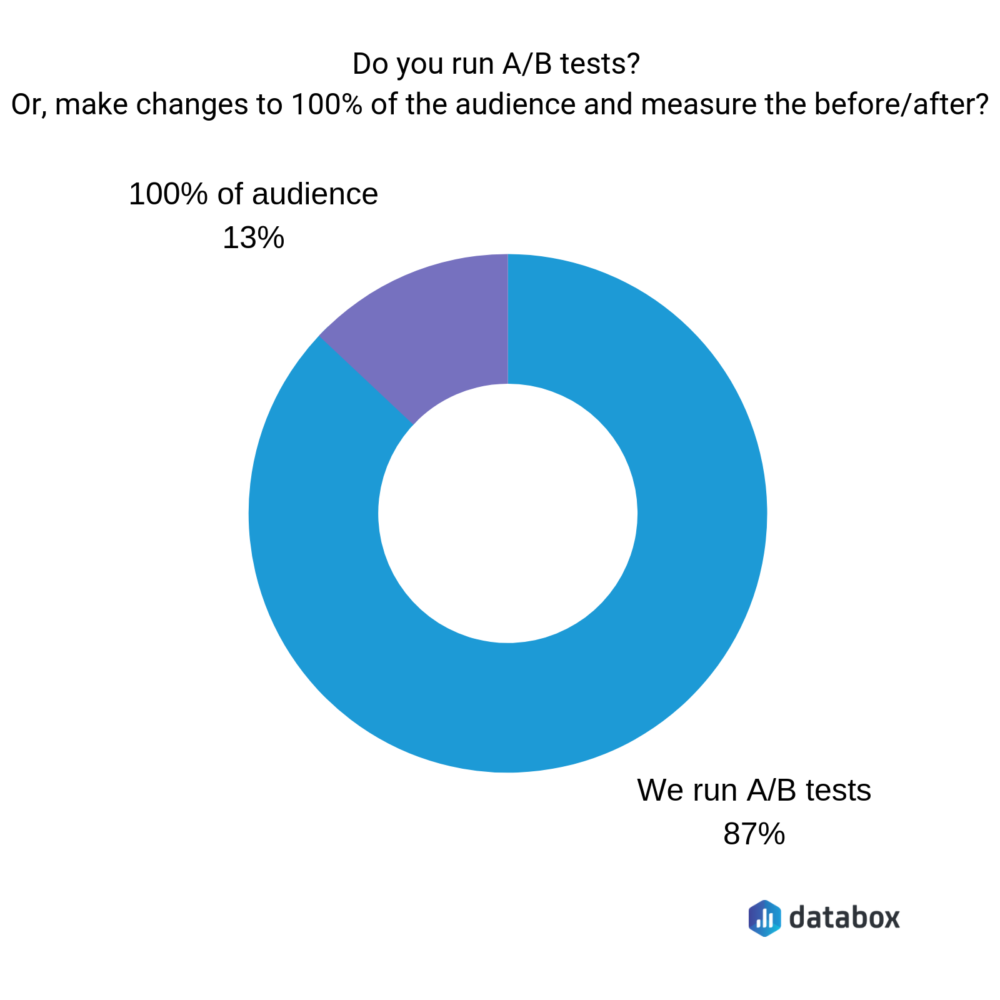
…Including Vital Design‘s Ian Kelley, who recommends to “create two versions of a landing page and test the layout depending on the goal (action you want the user to take) on that page. Test form length, page layout, headlines, amount of content, etc.”
“This will ensure you have the best possible converting landing pages going forward,” Kelly explains.
Which other pages should you be testing? The answer isn’t clear-cut. However, it’s common practice to prioritize A/B tests you believe will have a significant positive impact.
It’s what 95% of our experts do:
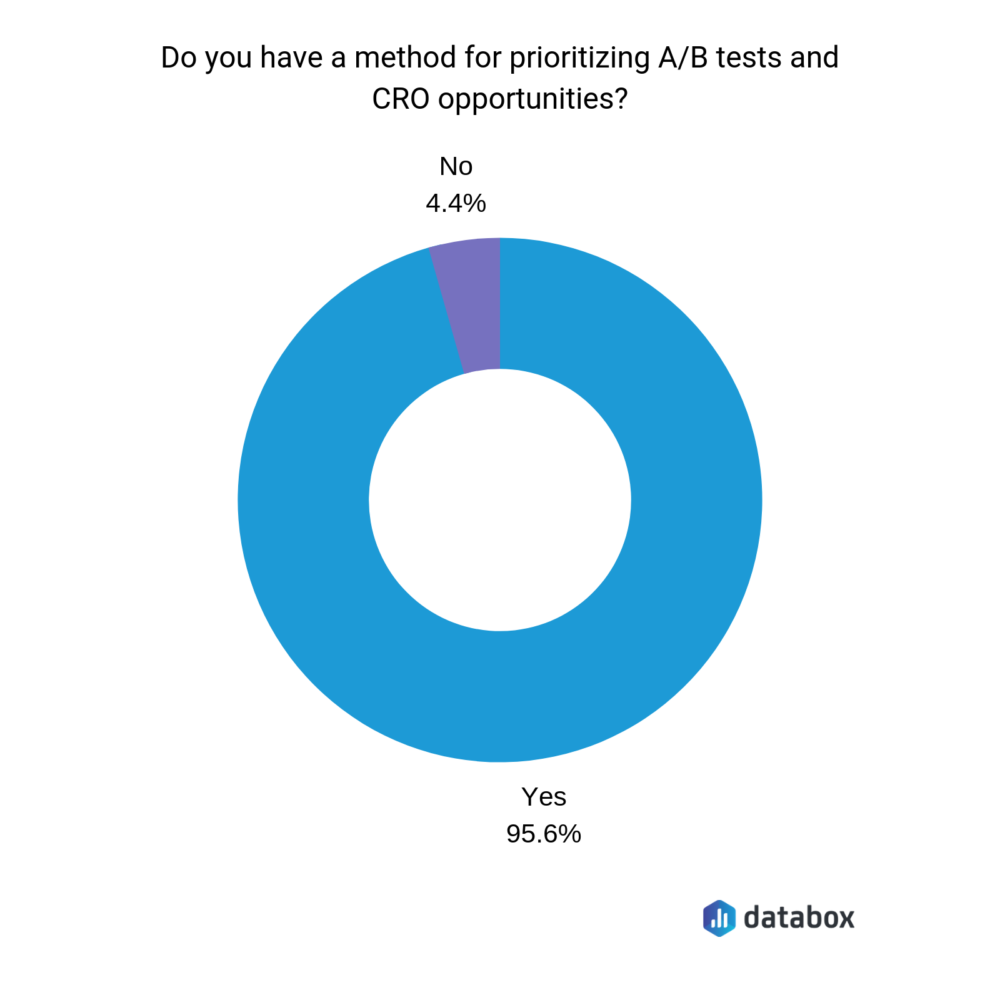
“Test first potentially high-impact pages. Don’t randomly test things, only test based on real insights, after formulating a hypothesis,” writes Laetitia Caron of IndustraCom. That’s usually “high traffic pages and stages in the (sales/conversion) funnel that don’t convert well.”
McCall Robison of Best Company, on the other hand, recommends this process: “When identifying high-leverage CRO opportunities, first look at what step of the conversion funnel your content is targeting: Awareness, evaluation, or conversion.”
Robison puts that into practice: “For example, say you are a personal loan provider and have two high-performing blog posts on your website, “What To Do If You Miss a Personal Loan Payment” and “What Is the Best Personal Loan for Consolidating Debt?” The second article has a higher-level CRO opportunity because it is targeting the conversion step. The people visiting that article are more likely to convert into a sale because they’re in the conversion step of the funnel, whereas the first article is targeting the Awareness step.”
“If your visitor isn’t there to convert or isn’t even thinking of converting, that’s when creating a CRO opportunity wouldn’t be worth the hassle,” Robison explains.
“So once you find pieces of content that are targeting the conversion stage, that’s when you can take advantage of the CRO opportunity and create an A/B test to determine if it works.”
Almost three-quarters of our experts prioritize A/B tests based on the potential impact if their hypothesis is accurate:
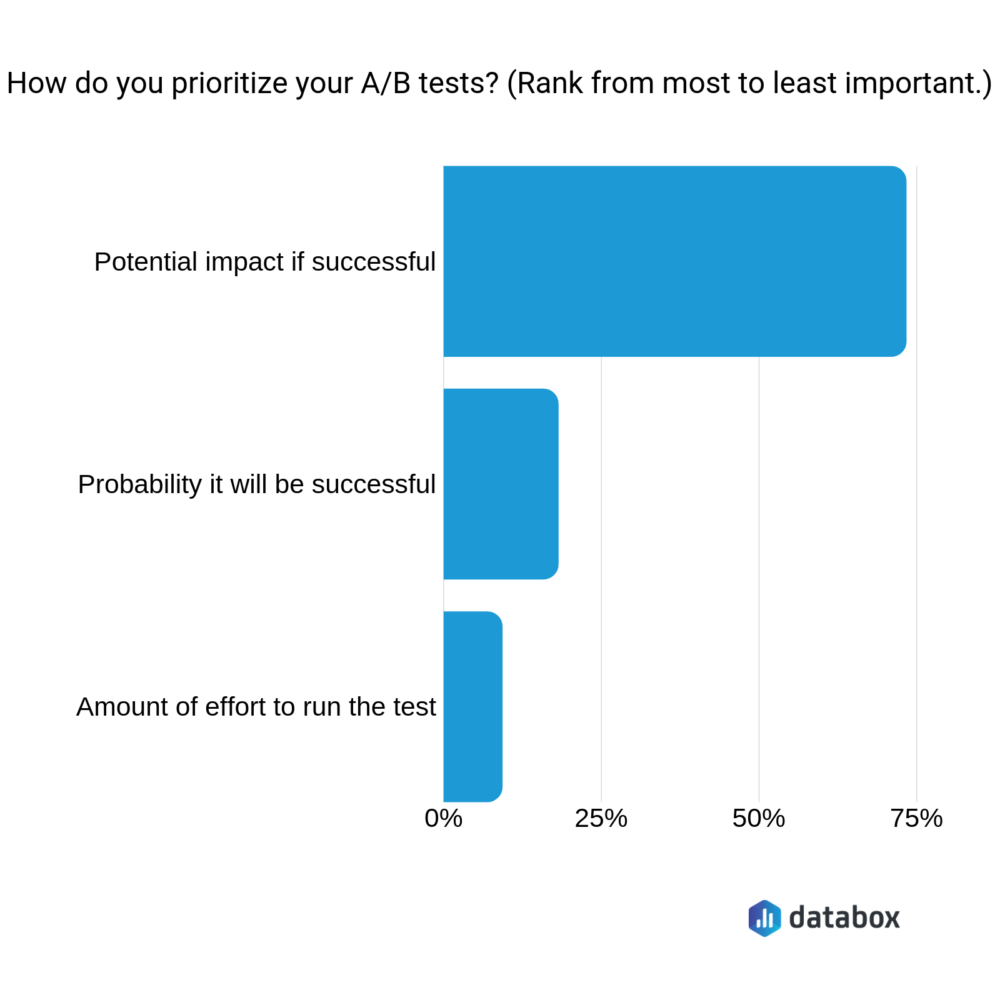
Akiva Leyton of Tablet Resellers takes a broad approach to prioritizing A/B tests, looking at “indicators such as click-through rate (how often an impression clicks on my ad text), bounce rate (how often someone clicks on my ad and then immediately leaves), and of course conversion rate (how often a visitor makes a purchase or fills out a form).”
However, Host Sorter‘s Lewis Thomas “simply target the pages that are already bringing in traffic or leads. This gives us a clear indication that something is already working correctly and can be improved upon. It is also a good allocation of our time as we can focus on work that will give us the most impactful results.”
“Once the A/B testing has been complete, we can then implement these changes for that particular page and any similar or upcoming page that we think fits into the same category,” Thomas continues.
Conversiono‘s top priority, on the other hand, is usually website copy, as Stacy Caprio explains: “Often the color of the page or the button on the page won’t make much of a difference in overall results when you look at the bigger picture, but changing the language you use on the page and how you speak to the customer will almost always have a significant result on end sales and profit.”
17. Don’t Forget to Optimize Your Buttons
“There’s usually some very low hanging fruit when it comes to optimizing most sites: the call-to-action buttons,” Ashlee Rolkowski, Marketing Consultant at Databox Premier Partner, Lone Fir Creative shared.
“Do you know what the two least exciting words in the English language are? ‘Learn more.’ Closely followed by ‘read more’. And yet, this stale, vague copy has become the default button text on so many websites, newsletters, and emails. Unless you’re a history professor ending a particularly riveting lecture on a cliffhanger, there’s no reason you should wrap up anything with ‘learn more.’ Remember, a button is a call to action. So it’s incredibly valuable to spend a little extra time testing and refining your buttons rather than using the same old empty phrases.”
Rolkowski continued, “You’re probably thinking to yourself, ‘How creative can you be with a button?’ There’s only enough space for a few words. A good starting point in most cases is to use more conversational language. For example, let’s say you strike up a conversation with someone at a networking event. You’re getting along swimmingly and realize you might want to work together. When you give the other person your email or phone number are you more likely to say ‘contact me’ or ‘let’s talk’?
Figuring out the right phrases doesn’t necessarily come down to random inspiration or blind luck. At Lone Fir Creative, we’re constantly running A/B tests that help us objectively measure the effectiveness of the language we’re using.
The main action we want people who come to our homepage to take is to get in touch with us. So naturally, we just slapped Contact Us on a button and called it a day, right? Of course not! We donned our data-driven lab coats and started experimenting.
From February 2, 2020 through April 19, we A/B tested a contact button with ‘Let’s Talk’ versus ‘Schedule a Call’. Notice [in our data below] that we didn’t run the test for one week, but for multiple months. Testing takes time and patience to produce actionable data
To be honest, we didn’t expect ‘Let’s Talk’ to be super effective. It’s unclear and open-ended whereas ‘Schedule a Call’ gives more specific direction on what we want someone to do. But as you can see, ‘Let’s Talk’ was the clear winner. It got almost double the number of clicks and the submission rate was five percentage points higher. That’s why it’s so important to test things out. Our assumptions and best practices aren’t always correct.”
Why aren’t our assumptions always correct? Rolkowski explains, “On the surface, so much of marketing appears to come down to subjective creativity and personal preference. The copywriter on the team liked the way this line sounded so we went with that. Or the art director likes the color green so that’s why the button is green. While creativity is still the heart of this business, data is the brain that helps us make more informed decisions that get results for us and for our clients.
Buttons are just one element that can transform your website into a high-performing money-making machine. When we’re building a new or optimizing an existing website, the first thing we do is audit the performance of the current pages, offers and buttons (of course).”
Need help developing an A/B testing and messaging strategy for your website? Request a free data-focused audit of your website messaging from Lone FIr Creative.
It’s time to start finding CRO opportunities
One report found just 22% of businesses are satisfied with their conversion rates. If that’s you, dig through sales data, your marketing funnels, and start A/B testing elements you predict having the best chance of success.
Follow the advice by Colibri Digital Marketing‘s Andrew McLoughlin: “We always look for the weak spots in our performance, and turn those into opportunities.”
“That way, we risk less and stand to gain so much more.”






